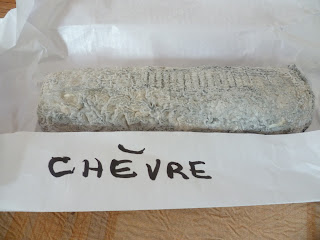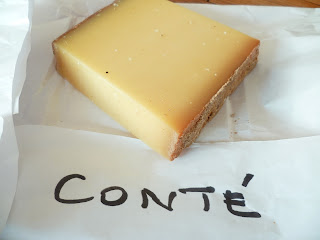While I was at Soline's house these past two days we embarked on several little adventures. The following is of our trip to the cheese stop in order to buy cheese for her son (and for ourselves) who she will be visiting in Belgium tomorrow.
Here is a picture of the store card:

And below you have an image of the plentiful amount of cheeses you can buy for just a little under 85 dollars..


Now I will introduce you one by one to some of our stinky characters.
 |
Marie Harel, created the original Camembert cheese from raw milk, in Normandy, France, in 1971. Today, however, a very small percentage of producers make cheese from raw milk with the same process as Marie Harel would have used. Those that do produce cheese using this method can legally call their cheese Camembert Normandie under the AOC guidelines. However, the production of Camembert cheese has now transcended the AOC designation. Very good varieties of Camembert cheese made from pasteurized milk can be found in Normandy today. The best of them is the Camembert Le Châtelain.
*THIS CHEESE IS ONE OF MY FAVORITES
|
 |
Produced at the Abbaye Notre-Dame de Bonne Espérance (our Lady of Good Hope) in the Dordogne, near Double in France, Trappe Echourgnac is made from pasteurized cow’s milk. The Abbey produces two versions of the cheese; a traditional recipe based on Port Salut and a newer version of the same cheese but washed with walnut liqueur (pictured)
* THIS CHEESE IS NOT FOUND IN A SUPERMARKET |
 |
Reblochon AOC is a semi-soft, washed-rind and smear-ripened mountain cheese that originated at the heart of the massif des Aravis, in the Thônes region of Haute-Savoie in France. The cheese was decreed as an A.O.C. cheese in 1958 and therefore is subject to strict rules and regulations. It is a lightly pressed, uncooked cheese, made from full-cream unpasteurized milk. Thirteenth century fables tell of Savoie herdsmen who carried out an incomplete milking of the cows in order to reduce their ‘taxable’ production of milk. After the rent was paid to the landowners, they went back to ‘remilk' (reblocher) the cows. The second milking of cows yielded a milk rich in fat and was used to make Reblochon.
*ALSO ANOTHER CHEESE I ADORE |
 |
The French “Gruyère” is a milk-based cheese made in Savoie and Franche Comté. It bears a cooked, pressed texture, of which the round piece has an average weight of 88 lbs. The round piece’s height is between 5.1 and 6.3 inches for a diameter between 20.9 and 24.8 inches. During production, the cheese develops holes, which vary in size. During maturation, it develops a pleasant strong and fruity taste. Its ideal consumption period runs from June to December, after eight to 12 months of maturing.
The geographical zone of production stretches from Haute-Saône’s plateau in the North to Savoie in the South.
The milk dedicated to Gruyère’s production comes only from dairy herds composed of Abondance, Tarentaise, Montbéliarde, Vosgienne and French Simmental breeds of cows.
France’s Gruyère designation must not be mistaken with its Swiss homonym. The international Stresa Convention on cheeses in 1951 recognized the word “Gruyère” as both a French and Swiss property, both countries possessing the right to use it.
This recognition in PGI allows the preservation of a cultural and gastronomical heritage. Previously, only the Swiss “Gruyère” could claim a geographical designation. The distinction between the two cheeses, apart from their place of production, is based on whether the cheese has holes. The French Gruyère is the only kind to present this characteristic.
|
 |
Saint-Nectaire is a French cheese made in the Auvergne region of central France. The cheese has been made in Auvergne since at least the 17th century. Its name comes from the Marshal of Senneterre (a linguistic corruption of "Saint-Nectaire"), who served it at the table ofLouis XIV. The Marshal of Senneterre is also responsible for the introduction of Cantal and Salers.
*ATE THIS CHEESE TONIGHT RATHER THAN A PROPER DESSERT |
 |
| Tomme de Savoie is a variety of Tomme cheese from Savoie in theFrench Alps. It is a mild, semi-firm cow's milk cheese with a beige interior and a thick brownish-grey rind. |
 |
Chevre is French for Goat’s cheese i.e. cheeses made out of goat’s milk. They are popular among elderly and children who are more likely to show low tolerance to cow’s milk. Also, goat cheeses are lower in fat, and higher in vitamin A and potassium. They serve as a perfect substitute for many dieters. A majority of goat cheeses come from France, the most famous among them being Bucheron, Chabis and Crottin de Chavignol.
*DO NOT BE FRIGHTENED BY THE MOLD THIS CHEESE CAN BE MIGHTY GOOD |
 |
Brie au poivre (Brie with pepper) originally belongs to classic French Bries family. The cheese is characterized by its unique peppery crust which adds rustic flavor to sandwiches. The creamy and buttery taste of the cheese goes well with a rich Pinot Noir or Beaujolais.
*NOW WHY WOULD YOU ADD PEPPER TO SOMETHING ALREADY SO GOOD? |
 |
French cheese made from unpasteurized cow's milk in the Franche-Comté region of eastern France.
*I HAVE SEEN THIS CHEESE BEEN EATEN IN ENORMOUS QUANTITIES |
My goodness I hope that you made it all right through my post. Imagine if I reported on every cheese I ate here in France.. we would be sitting at the computer for hours.















Deli!
ReplyDeleteTQM
Hola Juli,
ReplyDeleteEsta muy bonita la ciudad de Chartes con sus monumentos, y muy sugestiva con tal variedad de quesos. Gracias por las ilustraciones que nos transportan alla.
Abrazos,
Abuelitos Rafael y Gloria